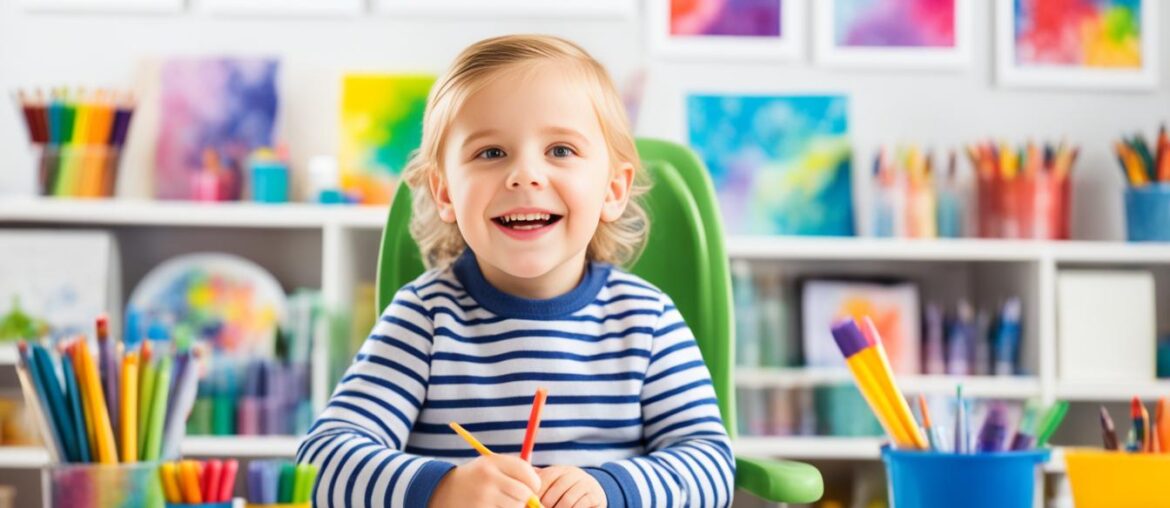As a parent, I have witnessed firsthand the impact of anxiety on children. Seeing my own child struggle with overwhelming worry and fear was heartbreaking. It affected their everyday life, from school performance to social interactions. I knew I had to find a way to help them manage their anxiety and restore their joy and confidence.
That's when I discovered the incredible power of art therapy for children with anxiety. This transformative approach harnesses the healing potential of creative expression, providing a safe and nurturing space for children to explore and process their emotions. Through art therapy, children can tap into their inner strength, discover new coping mechanisms, and cultivate a deeper sense of self-awareness.
Our Top Pick For Beating Panic Attacks

Stopping, and preventing, panic attacks is now even easier.
In this guide, I will take you on a journey through the world of art therapy, sharing its benefits, techniques, and interventions that can effectively alleviate anxiety in children. Together, let's empower our children to overcome their anxieties and embrace a brighter, more vibrant future.
Key Takeaways:
- Art therapy offers a creative outlet for children with anxiety to express their emotions.
- Both art therapy and play therapy can enhance general wellness and self-esteem in children.
- Anxiety disorders in children can significantly impact their daily functioning and overall well-being.
- Art therapy provides a non-threatening environment for children to explore and process their emotions.
- Art therapists play a vital role in facilitating the therapeutic process and creating a safe space for children.
The Power of Art Therapy for Children
Art therapy provides children with a powerful platform for communication and learning. Through art and play, children can express their thoughts and emotions in a safe and supportive environment, even when they struggle to find the right words. The creative process involved in art therapy allows children to bypass defense mechanisms and externalize their inner experiences, leading to transformation and growth.
By engaging in art therapy, children can practice mindfulness, develop self-expression skills, and process big emotions. This therapeutic approach helps children gain a sense of control and self-efficacy over their anxiety, nurturing their mental well-being.
Art therapy allows children to explore their creativity and emotions through various artistic mediums such as painting, drawing, and collage-making. The act of creating art enables children to tap into their inner world and gain insights into their anxiety, leading to a deeper understanding of their emotions.
Art therapy provides a safe space for children to express their thoughts and emotions, even when words fail them. It gives them a voice and an opportunity to communicate their experiences in a way that feels comfortable and natural.
Through art therapy, children can develop greater self-awareness, emotional resilience, and coping strategies. It also promotes social interaction and connectivity, fostering a sense of belonging and support among peers. Art therapy benefits children by enhancing their self-esteem, promoting personal growth, and nurturing their overall mental health.
Understanding Anxiety in Children
Anxiety disorders in children, such as Generalized Anxiety Disorder (GAD), can have a significant impact on their daily lives. Children with anxiety often experience excessive worry and apprehension about various events or activities, such as school performance and social interactions. These symptoms can interfere with their overall well-being and daily functioning.
Recognizing and addressing anxiety in children is crucial to prevent it from becoming more severe and affecting their mental health in the long term. By identifying anxiety early on and providing appropriate support, we can help children develop healthy coping mechanisms and improve their overall quality of life.
Signs and Symptoms of Anxiety in Children
Anxiety in children may manifest through various signs and symptoms, which can vary from child to child. Some common indicators of anxiety in children include:
- Excessive worry or fear about everyday activities
- Difficulty concentrating or focusing
- Restlessness or irritability
- Sleep disturbances or nightmares
- Physical symptoms such as headaches or stomachaches without any underlying medical cause
If you notice these signs in your child, it's essential to seek professional help to determine whether they are experiencing anxiety.
The Impact of Anxiety on Child Mental Health
Anxiety can significantly impact a child's mental health and overall well-being. It can affect their self-esteem, academic performance, social relationships, and ability to engage in everyday activities. Without proper management, anxiety can escalate and lead to more severe forms of anxiety or other mental health conditions later in life.
That's why early intervention and appropriate treatment, such as child art therapy, are vital in supporting children with anxiety and promoting their mental health.
Child Art Therapy for Anxiety Management
Child art therapy is an effective therapeutic approach for managing anxiety and promoting emotional well-being in children. Through art therapy, children can express their thoughts, feelings, and worries in a non-verbal and creative way.
“Art therapy provides children with a safe and supportive space to explore their emotions and anxieties. By engaging in artmaking, children can externalize their inner experiences and develop a sense of control over their anxiety.”
By engaging in art therapy, children can develop coping strategies, improve emotional regulation, and enhance their self-esteem. Art therapy also fosters self-expression, creativity, and self-awareness, allowing children to gain valuable insights into their anxiety and promote their overall mental well-being.
Through a combination of art therapy techniques and a trusting therapeutic relationship with a qualified art therapist, children can learn to manage their anxiety and build resilience for a brighter future.
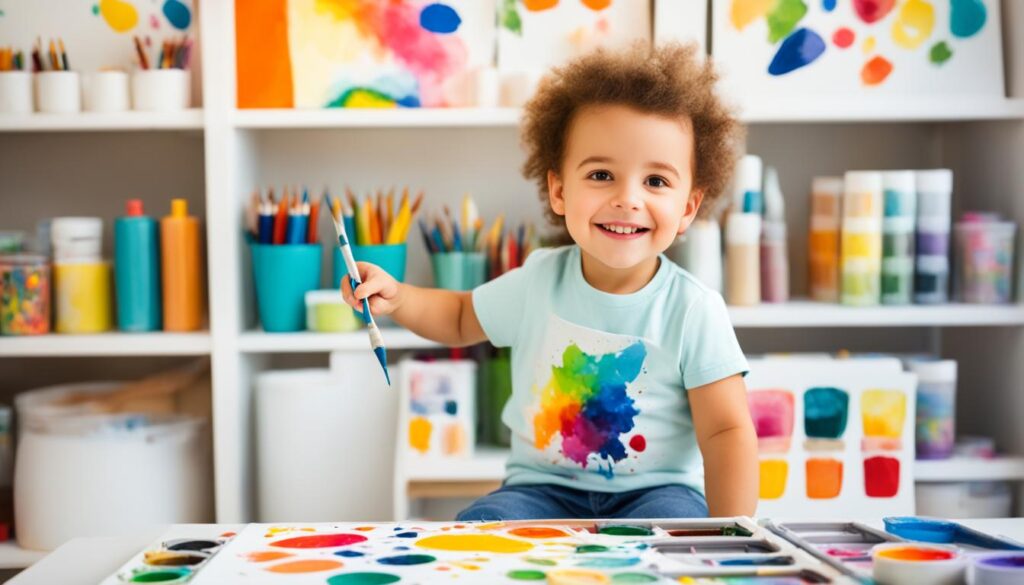
The Role of Art Therapy in Anxiety Treatment
Art therapy plays a vital role in the treatment of anxiety in children. It provides a safe and non-threatening environment for children to express and process their emotions, allowing them to develop self-awareness and emotional resilience. Through the creative process, art therapy helps children externalize their inner experiences and explore their thoughts and feelings in a tangible and visual way.
Art therapists are essential in facilitating the therapeutic process. They create a judgment-free space where children can freely explore their emotions through different art mediums. By building a trusting and supportive relationship with the child, art therapists empower them to express themselves authentically and gain valuable insights into their anxiety.
Art therapy interventions are tailored to meet the unique needs of each child. Art protocols and assessments are used to assess the child's progress and guide the therapeutic journey. These interventions can range from guided art exercises to creating art journals or using specific art techniques to address anxiety symptoms.
Art therapy allows children to find their voice, express their fears, and develop healthy coping mechanisms. It taps into their natural creativity and imagination, helping them gain a sense of control and empowerment over their anxiety.
Image:
By engaging in art therapy, children can gain the following benefits:
- Improved emotional regulation and coping skills
- Enhanced self-esteem and self-awareness
- Increased social connections and communication
- Development of problem-solving abilities
Art therapy provides a holistic approach to anxiety treatment, addressing the emotional, cognitive, and behavioral aspects of anxiety. By incorporating art therapy into the therapeutic process, children with anxiety can find meaningful ways to manage their symptoms and foster their overall well-being.
Incorporating Play Therapy in Anxiety Treatment
Play therapy is a powerful intervention for managing anxiety in children. Through play, children can communicate and express themselves in a natural and comfortable way. Play therapy techniques provide children with the opportunity to engage in various social situations, explore their emotions, and develop essential skills for coping with anxiety.
During play therapy sessions, children can engage in creative play, role-playing, and storytelling to express their thoughts, feelings, and fears. This form of therapy allows children to gain a deeper understanding of their emotions and develop effective strategies for managing anxiety.
The Benefits of Play Therapy for Children with Anxiety
1. Emotion expression: Play therapy enables children to emote and release their feelings in a safe and non-threatening environment. By giving them the freedom to play and explore, children can express their anxiety through play, promoting emotional release and stress reduction.
2. Social skill development: Play therapy techniques provide children with opportunities to practice social interactions and develop vital social skills. Through play, children can learn how to initiate and maintain conversations, problem-solve, cooperate with others, and build friendships.
3. Confidence building: Engaging in play therapy can boost a child's self-confidence and self-esteem. As they gain mastery over challenging play tasks and overcome obstacles, children develop a sense of accomplishment and empowerment, which can positively impact their anxiety levels.
Group Play Therapy: A Supportive Environment for Children
Group play therapy can be especially beneficial for children with anxiety. In a group setting, children have the opportunity to interact with peers who may be experiencing similar challenges. This environment provides a supportive and empathetic network, fostering a sense of belonging and reducing feelings of isolation.
In group play therapy, children can learn from one another, share their experiences, and develop valuable social skills. The group dynamic encourages cooperation, empathy, and understanding, helping children navigate their anxiety in a collaborative and supportive atmosphere.
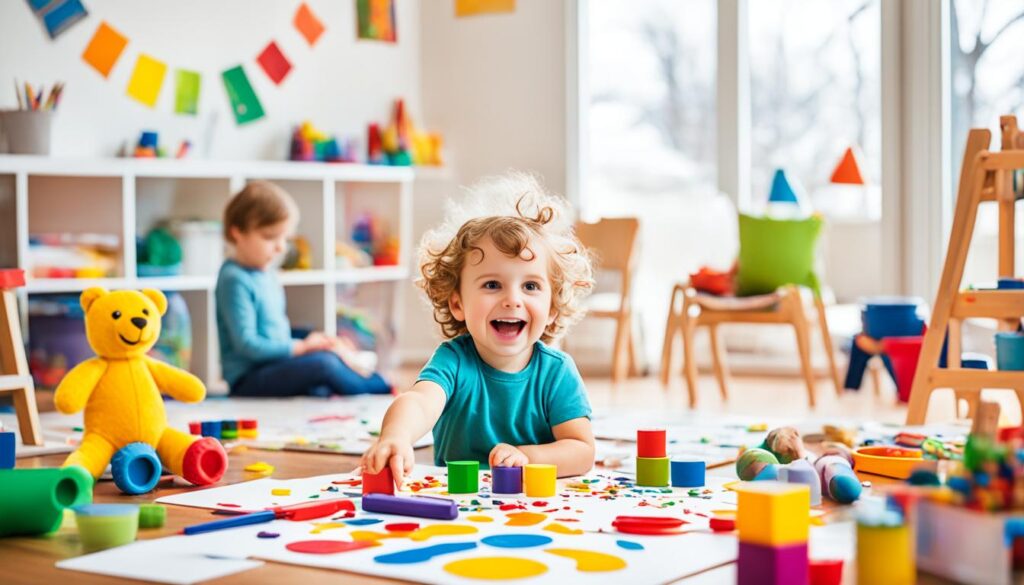
Integrating Play Therapy and Art Therapy Techniques
Art therapy can complement play therapy in anxiety treatment for children. By combining art and play, practitioners can offer children a holistic and multi-dimensional approach to expression and healing. Art therapy techniques, such as drawing, painting, and sculpting, can provide additional outlets for self-expression and creativity, enhancing the therapeutic benefits of play therapy.
| Benefits of Incorporating Play Therapy and Art Therapy Techniques: | |
|---|---|
| 1. Increased self-awareness | Children can gain a better understanding of their emotions and triggers by engaging in both play and art therapy. These techniques encourage introspection and facilitate emotional exploration. |
| 2. Enhanced coping skills | By combining play and art therapy, children can develop a diverse range of coping strategies to manage their anxiety. These strategies can include deep breathing exercises, visualization techniques, and self-soothing activities. |
| 3. Promotion of self-expression | The combination of play and art therapy allows children to express themselves in multiple ways. They can use words, gestures, symbols, and colors to convey their thoughts and emotions, providing a comprehensive outlet for self-expression. |
By incorporating play therapy and art therapy techniques, practitioners can offer children a rich and transformative therapeutic experience. This integrated approach addresses the unique needs of children with anxiety, helping them develop essential skills and strategies for managing their emotions and achieving overall mental well-being.
Cognitive Behavioral Therapy as a Complementary Approach
Cognitive Behavioral Therapy (CBT) is an effective complementary approach in managing anxiety in children. When used alongside art therapy and play therapy, CBT can provide a comprehensive treatment plan that targets the underlying causes of anxiety.
CBT focuses on identifying and challenging negative thoughts and beliefs that contribute to anxiety. By addressing cognitive distortions, children can gain a better understanding of their anxiety triggers and learn techniques to manage their symptoms effectively.
Through CBT, children acquire coping skills that enable them to confront their fears and replace irrational thoughts with more realistic and positive ones. This process enhances their ability to regulate their emotions and reduces overall anxiety levels.
One of the key advantages of combining CBT with art therapy and play therapy is the opportunity for children to practice their newly learned coping skills in a valuable and creative context. By incorporating art activities and playtime into therapy sessions, children can apply the strategies they've learned to manage their anxiety actively.
| Benefits of Cognitive Behavioral Therapy for Children with Anxiety | Benefits of Art Therapy for Children with Anxiety | Benefits of Play Therapy for Children with Anxiety |
|---|---|---|
|
|
|
By integrating CBT, art therapy, and play therapy, therapists can provide a comprehensive treatment plan that addresses the cognitive, emotional, and behavioral aspects of a child's anxiety. This combined approach empowers children to develop effective coping strategies and manage their anxiety in a holistic way.
Testimonial from a Child:
“Since starting my therapy, I've learned so many helpful techniques to deal with my anxiety. My therapist teaches me how to challenge my negative thoughts and replace them with positive ones. The art therapy and play therapy activities have also been really fun, and they help me express myself and relax. I feel more confident and in control of my anxiety now. Thank you!”
– Emily, 10 years old
Combining cognitive behavioral therapy with art therapy and play therapy offers a powerful and well-rounded approach to anxiety management in children. By addressing cognitive, emotional, and creative aspects, this integrative treatment approach provides children with the tools they need to thrive and overcome their anxiety challenges.
Art Therapy Techniques for Anxiety Management
Art therapy offers a variety of techniques that can effectively help children manage their anxiety. Through the use of creative expression, such as painting, drawing, collage-making, and more, children can explore their emotions, gain insights into their anxiety, and develop coping strategies.
The choice of art materials in art therapy sessions is crucial as it allows children to engage with their preferred mediums, tailoring the experience to their unique needs and preferences. Crayons, markers, paint, pastels, and other art supplies can be selected to create a safe and comfortable environment for the child's self-expression.
By engaging in these art therapy techniques, children can not only externalize their feelings but also develop a deeper understanding of their anxiety. Creating visual representations of their experiences helps them process emotions that may be challenging to express verbally. Through their artwork, children can communicate their inner thoughts, fears, and anxieties, empowering them to find their voice and gain a sense of control over their emotions.
Art Therapy Techniques for Anxiety Management
1. Painting: Encourages self-expression and emotional release, allowing children to explore different colors, textures, and techniques to convey their feelings.
2. Drawing: Provides a means for children to express their anxiety visually and communicate complex emotions through creating images and symbolism.
3. Collage-making: Allows children to assemble various visual elements, textures, and materials to create a cohesive representation of their thoughts and feelings.
4. Sculpting: Offers a tactile experience that engages the senses, providing a physical outlet for anxiety and a means to express emotions through three-dimensional art forms.
5. Guided imagery: Involves visualizing calming and positive scenarios, which children can then illustrate through art, promoting relaxation and reducing anxiety.
6. Journaling: Combining art with written reflection, journaling allows children to explore their thoughts and emotions in a safe and private space.
7. Group art therapy activities: Engaging in art therapy techniques within a group setting can foster social connections, provide peer support, and normalize experiences, helping children understand that they are not alone in their anxiety.
By incorporating these art therapy techniques into anxiety management, children can find solace, gain self-awareness, and develop healthy coping mechanisms. Through their artistic creations, they can embark on a therapeutic journey of self-discovery and emotional well-being.
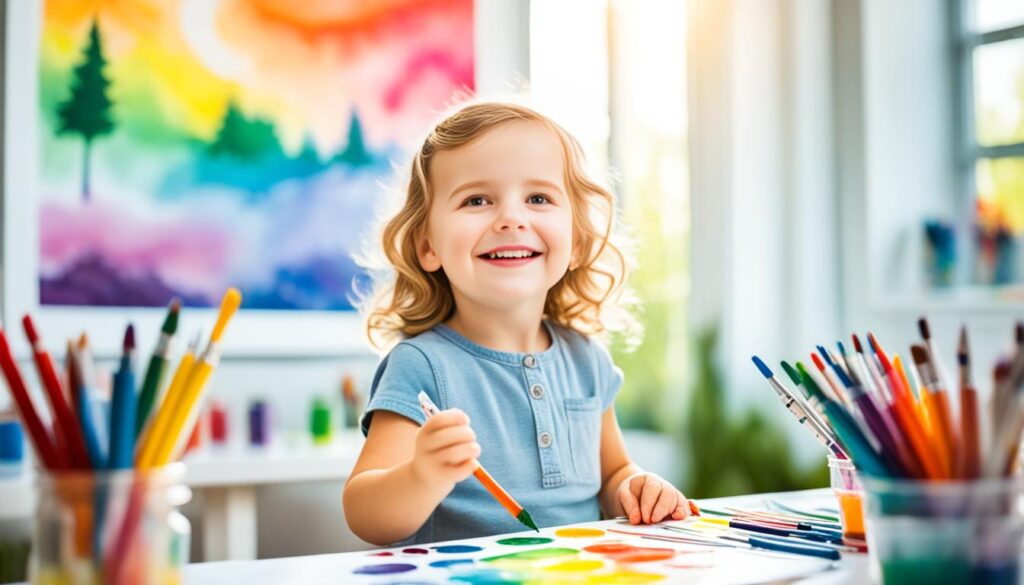
| Benefits of Art Therapy Techniques for Anxiety Management |
|---|
| Enhances emotional expression and communication |
| Develops self-awareness and introspection |
| Promotes relaxation and stress reduction |
| Builds coping skills and emotional resilience |
| Provides a sense of control and empowerment |
The Role of the Art Therapist
Art therapy for children with anxiety relies on the expertise and guidance of the art therapist. This role is critical in creating a safe and supportive environment that allows the child to explore their emotions through art.
As an art therapist, I encourage open communication and creative expression during the artmaking process. By establishing trust and rapport with the child, I foster a connection that enables them to feel comfortable and confident in sharing their thoughts and feelings.
Guiding the child through the art therapy sessions, I facilitate their exploration of emotions and provide insights into their artwork. I help them interpret the symbols, colors, and composition, encouraging self-reflection and personal growth.
Art therapists provide a safe and judgment-free space for children to express themselves and develop coping strategies.
Throughout the course of therapy, I continuously assess the child's progress and adapt the art therapy interventions accordingly. This ensures that the child receives the most effective and beneficial treatment tailored to their individual needs.
Benefits of the Art Therapist
The art therapist's expertise and guidance add immense value to the art therapy process. By connecting with the child on an emotional level, the therapist fosters trust and creates a supportive environment. This enables the child to freely express themselves and gain a deeper understanding of their emotions.
The art therapist's role extends beyond facilitating creative expression. Through careful observation and interpretation of the child's artwork, the therapist can identify patterns, themes, and emotions that may be difficult for the child to express verbally.
Additionally, the art therapist's assessment and adjustment of art therapy interventions ensure that the treatment is tailored to the child's progress and evolving needs. This individualized approach enhances the effectiveness of art therapy as a therapeutic modality for children with anxiety.
Overall, the art therapist plays a crucial role in supporting children with anxiety through art therapy. Their expertise, empathy, and personalized approach contribute to the child's emotional well-being and growth throughout the therapeutic process.
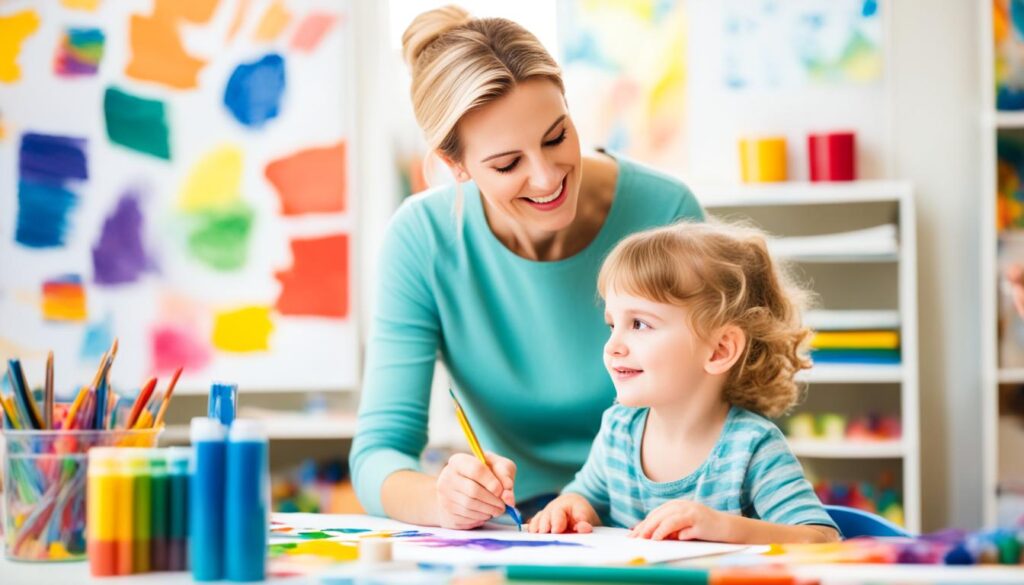
> “Art therapists provide a safe and judgment-free space for children to express themselves and develop coping strategies.”
Benefits of Art Therapy for Children with Anxiety
Art therapy offers numerous benefits for children with anxiety. It is a powerful therapeutic approach that combines creativity with mental health support, helping children navigate their emotions and develop effective coping strategies. Through the use of artistic expression, children can explore their inner world, build self-confidence, and find a sense of control over their anxiety.
Enhancing Self-Esteem and Self-Awareness
Art therapy allows children to express themselves freely and authentically, fostering a positive sense of self-esteem. By creating artwork, children gain a deeper understanding of their thoughts, feelings, and experiences. They can visually represent their emotions and gain insights into their anxiety triggers, strengths, and areas for growth.
Improving Emotional Regulation and Coping Skills
Engaging in art therapy provides children with a safe outlet to process and regulate their emotions. Through artmaking, children can externalize their anxiety and channel it into creative expression. Art therapy techniques help children develop coping skills, such as deep breathing, drawing boundaries, and practicing mindfulness, which they can apply in their daily lives to manage anxiety-inducing situations.
Fostering Social Connections and Communication
Art therapy often takes place in a group setting, allowing children to connect with others who may share similar experiences or challenges. Group sessions provide opportunities for social interaction, collaboration, and peer support. Through engaging in art activities together, children can build social skills, strengthen their communication, and develop a sense of belonging.
Providing a Sense of Control and Empowerment
Anxiety can leave children feeling overwhelmed and powerless. Art therapy offers a sense of control and empowerment as children can make choices about their artwork, materials, and themes. This autonomy fosters confidence and resilience, enabling children to face their anxieties with a greater sense of control.
By incorporating art therapy into the treatment plan for children with anxiety, therapists and caregivers can create a supportive and nurturing environment for their emotional well-being. Through art-making, children can develop essential skills for managing their anxiety, fostering personal growth and mental well-being.
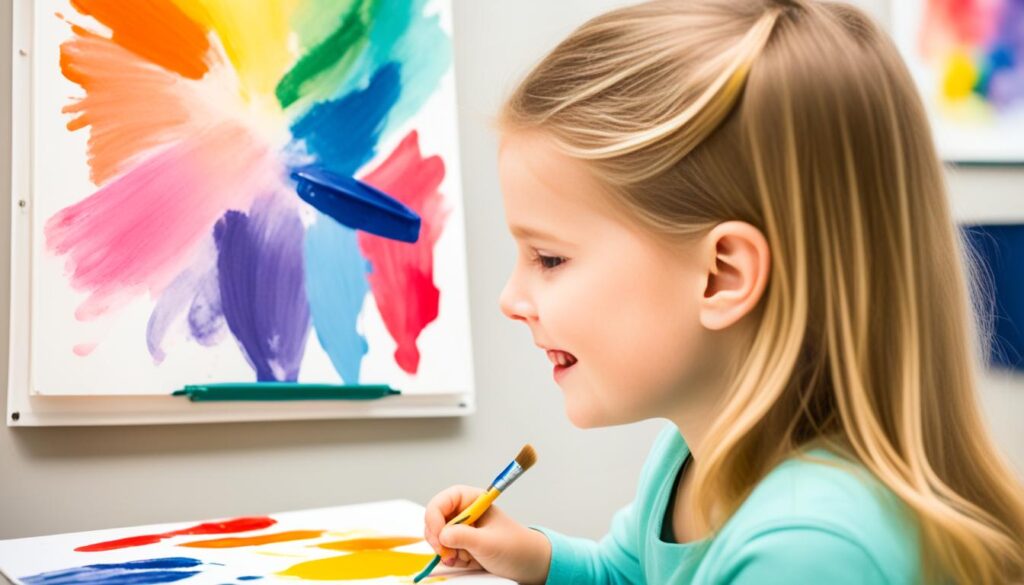
| Benefits of Art Therapy for Children with Anxiety | Keywords |
|---|---|
| Enhancing self-esteem and self-awareness | art therapy benefits, child mental health |
| Improving emotional regulation and coping skills | art therapy benefits, child mental health |
| Fostering social connections and communication | art therapy benefits, child mental health |
| Providing a sense of control and empowerment | art therapy benefits, child mental health |
Conclusion
Art therapy is a powerful tool that can greatly benefit children with anxiety. By incorporating art therapy techniques into their routine, children can discover creative avenues for managing their emotions and fostering mental well-being. Whether through individual or group sessions, art therapy offers a safe and supportive environment for children to express themselves, build coping skills, and develop a positive mindset for managing their anxiety.
Through art therapy, children can explore their inner world, gaining insights into their emotions and experiences. The creative expression therapy allows them to communicate and process their feelings, even when they struggle to put them into words. By engaging in art therapy techniques such as painting, drawing, and collage-making, children can externalize and transform their thoughts, leading to increased self-awareness and emotional resilience.
Art therapy interventions, combined with play therapy for anxiety and cognitive behavioral therapy, can provide a comprehensive approach to anxiety treatment. By addressing the root causes of anxiety and teaching children effective coping strategies, art therapy contributes to the overall well-being and development of child mental health. It empowers children to take control of their anxiety, fostering a sense of empowerment and promoting a positive outlook on life.
In conclusion, art therapy is an invaluable resource for children with anxiety. It not only provides a creative outlet for self-expression but also offers a therapeutic journey towards improved mental health. By incorporating art therapy into the lives of children, we can help them navigate their anxiety, build resilience, and develop the necessary skills to lead fulfilling and productive lives.
FAQ
What is art therapy and how does it help children with anxiety?
Art therapy is a form of therapy that uses creative expression to help individuals, including children, explore and communicate their thoughts and emotions. It provides a safe and non-verbal outlet for children with anxiety to process their feelings, develop self-awareness, and build coping skills.
What are the benefits of art therapy for children with anxiety?
Art therapy offers several benefits for children with anxiety. It can enhance self-esteem and self-awareness, improve emotional regulation and coping skills, foster social connections and communication, and provide a sense of control and empowerment.
How does play therapy complement art therapy in anxiety treatment?
Play therapy and art therapy are both effective interventions for managing anxiety in children. Play therapy allows children to express themselves and develop social skills, problem-solving abilities, and confidence. When combined with art therapy, it provides a comprehensive approach to anxiety treatment.
What is the role of cognitive behavioral therapy (CBT) in anxiety treatment?
Cognitive Behavioral Therapy (CBT) is often used in conjunction with art therapy and play therapy to address anxiety in children. CBT focuses on identifying and challenging negative thoughts and beliefs that contribute to anxiety. It teaches children coping skills and techniques to manage their anxiety more effectively.
What are some art therapy techniques for anxiety management in children?
Art therapy techniques for anxiety management may include painting, drawing, collage-making, and other forms of creative expression. The choice of art materials can be tailored to the child's preferences and needs, allowing them to explore their emotions, gain insights into their anxiety, and develop coping strategies.
What is the role of the art therapist in the art therapy process?
The art therapist plays a vital role in the art therapy process. They create a safe and supportive environment for the child, encourage open communication and creative expression, and guide the child through the artmaking process. The art therapist also assesses the child's progress and adjusts the art therapy interventions accordingly.
How can art therapy benefit children's mental health?
Art therapy can enhance children's mental health by improving self-esteem, self-awareness, emotional regulation, coping skills, social connections, and a sense of control. It provides a creative outlet for children to express their emotions and develop resilience in managing anxiety.
